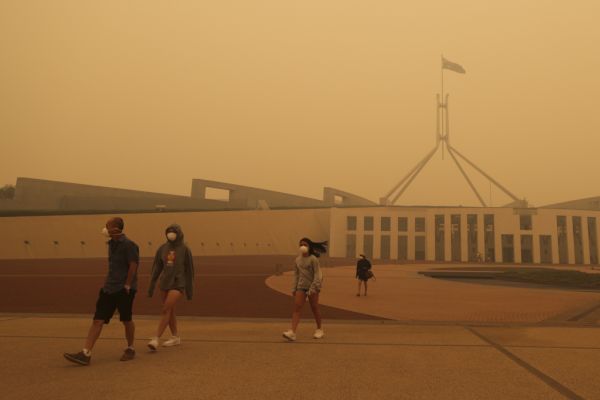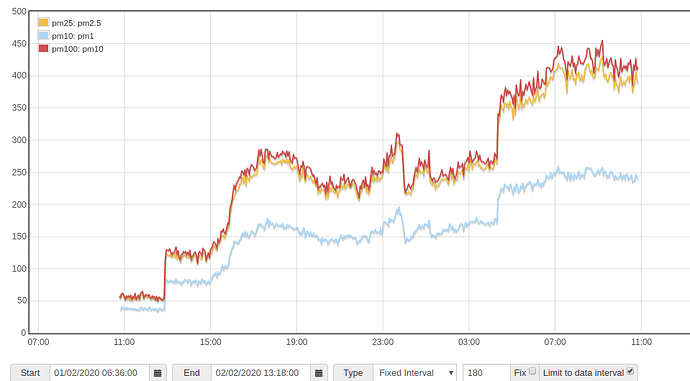Irrespective of how it is specified, the value should give an indication of the expectation for how long it might take for a significant change in air quality to occur.
CIBSE Guide A is a useful resource!
Replying to myself 
In looking for ways to link one of these into your system, I should have checked Tasmota. And of course there is already code there → GitHub - arendst/Tasmota: Alternative firmware for ESP8266 with easy configuration using webUI, OTA updates, automation using timers or rules, expandability and entirely local control over MQTT, HTTP, Serial or KNX. Full documentation at.
So if you have any of the esp8266 devices that can be loaded with Tasmota it’s a simple task to get a sensor up and running and sending the data.
It seems to make use of the mode commands which is good.
. Tasmota/xsns_20_novasds.ino at 8aa91096566c5a3d885c693c9f28cee387ec7b1b · arendst/Tasmota · GitHub
The start, stop and continuous mode commands for the SDS011 also at luftdaten:
. sensors-software/airrohr-firmware.ino at 8a936e1961fc31ba4a0e086e144b2dd6e01b8990 · opendata-stuttgart/sensors-software · GitHub
I found it interesting to see the other sensors they support.
An experiment could be made up to get the real stabilisation period for a reading. I would bet it’s less than 30 seconds.
Has anyone read this paper Bill linked in? I took a long moment to re-read it.
Regardless of how poor the study really is… SDS011 actually comes out quite well. The conclusions are there for anyone to read…
I’ve recently setup the Plantower AQS to try and get a measure of the local air quality after dreadful local bushfires on the south coast of NSW Australia. I bought the PM2.5 Air Quality Sensor and Breadboard Adapter Kit - PMS5003
Originally set it up inside the house, but now moved it outside. I’ve got it running under python on a laptop but will move it to an rPi when I can get the “off-grid” setup running (solar pv + battery). Having to have it near to a powerpoint is too restrictive.
The python script was modified from here and then merged with a paho-mqtt based script to send data to emonbase. It was surprisingly easy.
Here is a snapshot from the last 24 hrs or so - as another bushfire flared up about 50 km away. The jump around 1300h is when I moved the sensor outside.
I’m not entirely convinced about the accuracy, but it is probably enough to decide whether I should open the windows again!
I’m happy to share the python code if anyone is interested, but it’s still evolving!
Based on that I think you should consider going round all the cracks round the windows with a sealant gun!!!
Hope the fires don’t come your way.
Simon
Actually, looking at the UK government site for 2.5, I wonder if you aren’t a factor of 10 out.
Simon
I wish it was an error! The smoke has been extreme on some days - see news report from a few weeks ago:
We are about 200 km south east of Canberra, but most of the south east of the country is still having days of extremely poor air quality becuase of ongoing fires.
Image below is of our national parliament building:

We have a Philips room air filter unit inside which has real time pm2.5 monitoring and it hovers between 15-100 depending on air quality outside and whether we open/close the doors!
Hi,
Yes, I’d seen the photos, just hadn’t realised the readings were so high. I’d been looking at the scale as I’d just started trying out one of the sensors.
The photo looks a lot like Beijing in the early days I travelled there. Same colour. But in those times, it wasn’t traffic, the roads were still very empty, some bikes and an occasional Citroen based taxi, the issue were the steel works near the city. When you came back from a walk outside the hotel your throat was raw and your face felt like you’d had a chemical peel!!!
Fingers crossed for more rain for you in the coming weeks.
Simon
Wow, those readings are high! 
Frightening. Watch out Wales…

But then there’s always been that gulf stream and massive rainfall… Until…
Simon
The ESPEasy software allows you to turn off the fan and laser between reads. Then turns it back on 30 seconds prior to the next read. This is very easy way to set all this up without having to reinvent the wheel.
Do you mean rain to put out the bush fires?
This is the only way to really solve the problem in the short term as rain doesn’t really wash the smoke particles out of the air.
Put the fires out it needs relatively high and sustained rain, otherwise the tree trunks can keep burning for months.
Just about sensor: with Raspberry Pi I used the BME 680 / CJMCU-680 sensor, with very nice and seems like accurate results. It’s not cheap sensor but worth the price for me.
When you say the BME680 is accurate, I know the temperature, humidity and pressure are accurate, but what about the VOC part?
And just to say that VOC measurement is not the same as particle measurement. I have both, though neither is installed yet!
Yes, the VOC of the BME680 is measuring very different things to what the SDS011 is measuring. While there might be some correlation, that won’t always follow.
Sadly I’m not yet a sensor expert, but air quality is really correct values. Like with open window and fresh air, like 90% and after closed a small room’s window and 5 person here for hours, and feels “used air” air quality went down to 65%. After opening window again and feeling better, again near 90% the air quality.
The temperature with 2 digit, like 24,56 Celsius, and so fast response time. About humidity and pressure working, but I feel no real validation.
An improved manager for the dust sensor here @glyn.hudson.
An interval can be set to ensure the sensor spends most of it’s time asleep, increasing the lifetime of the laser, which with 24/7 on time has a rated life of only a few months. Setting readinterval to 5 (minutes) translates this rated life of 8000 hours to several years.
emonhub will need this library installed on an update.
. sds011 · PyPI


